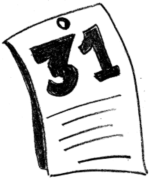 A task a day for 31 daysAs well as talking to students and observing lessons, a good way of getting a feel for what educational technology standards are like — and therefore whether you need to do anything about them — is to look at students' work. There's nothing to stop you talking to students about their work; indeed, that's what a good head of ICT would do. However, you can get through a lot more student work without having to talk about it. Therefore 'work scrutiny', as this is sometimes called, can be a useful supplement to the other things you're doing.
A task a day for 31 daysAs well as talking to students and observing lessons, a good way of getting a feel for what educational technology standards are like — and therefore whether you need to do anything about them — is to look at students' work. There's nothing to stop you talking to students about their work; indeed, that's what a good head of ICT would do. However, you can get through a lot more student work without having to talk about it. Therefore 'work scrutiny', as this is sometimes called, can be a useful supplement to the other things you're doing.
Without the student there to discuss it with you it can be hard to drwa and hard and fast conclusions. The way I think of work scrutiny is that it's a means of gaining enough of an overall impression to be able to ask some pertinent questions. The kind of things I would be thinking about as I looked through the work include:
- Are attainment levels appropriate?
- Is the amount of work adequate?
- Is there a good range of subject coverage?
- Is there a range of contexts?
- Does the work show progress over the year?
- Are literacy skills being developed?
- Are numeracy skills being developed?
- Are ICT skills being developed? Which ones?
- Are ICT skills being applied?
- Is work marked regularly and is the marking diagnostic?
- Is there evidence of extension work?
- Are pupils’ special educational needs being addressed?
- Are there differences in the work according to gender or ethnicity?
- Does the quality of the resources used enhance learning?
- Is there evidence of homework?
Many of these would be more appropriate if you have recently taken up the post of leader of the educational technology team, or if ICT is taught or used mainly across the curriculum. Otherwise one would assume that you already know the answers to questions like 'is there a range of contexts?'
Note that some of the questions are appropriate if you are trying to judge the standards attained by individual students. However, in the context of work scrutiny the main purpose is to look at the big picture.
I think this sort of exercise can work quite well if entered into in the same spirit as the lesson observations discussed on Day 11. The purpose is not to catch people out, but to see what things are like. In my opinion, it's a good idea to discuss as a team what sort of things to look for, and then for the whole team to look at the same samples of work.
The exercise can be quite revealing. Let's take that contexts question again. On scrutinising the work it may become clear that the range of contexts is very narrow, which means that you and your colleagues can start to address that right away. Similarly with marking: if most of it is of the 'tick, good' variety then there probably needs to be some discussion of assessment for learning approaches to marking. Often it is only when you step back and look at the thing as a whole that you can start to see such issues.
Ideally, take samples of work from a wide range of students. Also, bear in mind that you need to look at a substantial range of work from each student. If you don't, it's impossible to even begin to answer questions like 'Does the work show progress over the year?' or 'Is the amount of work adequate?'
Also, it's worth bearing in mind that context is important. Take the question 'Is there evidence of homework?' When I was last Head of ICT, my scheme of work involved mainly extended project work, and so the homework each week was 'Do whatever you need to do in order to be able to get on with your project work in the next lesson.' I regarded that as perfectly adequate, because it was entirely appropriate. But there was no hard evidence in students' portfolios of homework having been done: you'd have to infer it.
You also need to know about context from the point of view of knowing what the student was required to do and how much help they had, when trying to infer their level of understanding.
Together with talking to students, looking at the data, observing lessons, and having an external person's opinion (covered on Day 13), work scrutiny can give you a real insight into the state of educational technology in your school. That knowledge can help you concentrate resources of people, time and money most effectively.
